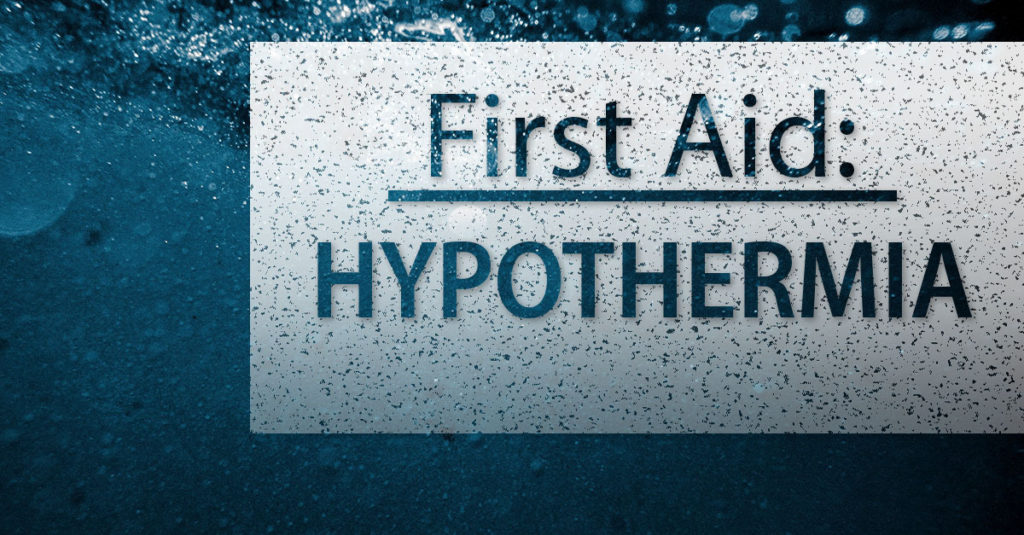I began writing this and then had the unfortunate, unique experience of becoming hypothermic. Hypothermia is a condition that is caused by cold. The body can begin having signs and symptoms of hypothermia when immersed in water as warm as 86F/30C degrees. There is a lot of water in the United States that is at or below 86F/30C degrees! Global freshwater temperatures typically average between 65F/18C to 75F/24C in the summer and 35F/2C to 45F/7C in the winter. Global surface temperatures of oceans are around 61F/16C. I will share a little about my experience and then talk about how to recognize, prevent, and treat hypothermia.
My experience with hypothermia
I work on a dive rescue recovery team. We were on a night recovery mission in spring, with water surface temperatures at 74F/23C. I was stationed on the surface as a 90%’er in a dry suit with minimal thermal protection. For the recreational/sport diver, this means 90% ready to go underwater and affect a rescue or other task that may become necessary. I was a little chilled but figured the feeling would disappear as soon as I began working. I was called upon to begin a search, and felt great underwater. I warmed up tremendously and was quite comfortable. The pattern was a little rough due to a few issues with my dive computer compass and orientation. I was diving in near zero visibility with unfamiliar terrain at night, but remained calm in executing my task. It was then determined by command to surface. As I slowly ascended, I began feeling extremely cold within about three meters of the surface. Once on the surface I had a brief conversation with another diver, and then began to shiver uncontrollably. It was observed that I was blue and was subsequently rushed to shore for assessment by paramedics and crew. It took a little while to recover to normal temperature, but I recovered without any other complications.
Recognizing hypothermia
Normal body temperature is 98.6F/37C. According to the Cleveland Clinic, hypothermia begins when the body temperature drops below 95F/35C. The Cleveland Clinic states that hypothermia can occur in temperatures above 104F/40C in conditions in which a body gives off more heat than it generates, such as a wet and windy environment, or when combined with other medical conditions such as diabetes. Never discount hypothermia just because it is hot outside.
How do you tell if someone is in danger?
There are three stages of hypothermia. Most will only see one or two stages, but hypothermia can very easily result in death if left untreated.
The signs of mild hypothermia consist of:
- Shivering
- Chattering teeth
- Exhaustion
- Clumsiness
- Slow reaction time
- Being prone to falling
- Weak pulse
- Tachycardia (rapid pulse)
- Tachypnea (rapid breathing)
- Pale skin
- Confusion or loss of awareness
- Excessive urination
The second stage is a little more frightening and unfortunately the stage I progressed to. Core body temperature ranges between 89.6F to 82.4F.
- The heart and breathing begin to slow
- Slurred speech or difficulty speaking
- Decline in mental function
- Loss of shivering
- Bluish in color
- Muscle stiffness
- Dilated pupils
- Arrythmias (heart abnormalities)
- Hypotension (decreased blood pressure)
- Muscle weakness
- Loss of consciousness
The final stage of hypothermia is a core temperature below 82.4F/28C.
- Hypotension
- Pneumonia (fluid in the lungs)
- Absence of reflexes
- Low urine output
These are the hallmark symptoms, followed by a coma mimicking death, and finally, death.
We all love to dive. Most of us want to maximize our time underwater and hate to call a dive. But remember, there is no room for ego! If you begin feeling cold you should end the dive or activity you are participating in. One of the first signs of feeling cold is goosebumps. The medical term for this is excitement of the erector pili muscles. Many of us wear at least a wetsuit so you may not see goosebumps, but shivering is an easily recognizable sign. If your dive buddy is shivering, there is a problem. Make sure they know you are okay with calling the dive. There are other days to dive and you do not want to end up a statistic on dives gone bad.
Things to look for in a buddy who seems cold
If their lips and nail beds are pure white, it means the body has already started shifting the blood to the core, protecting the organs. Medical professionals call this compensated shock. Delayed capillary refill is when blood does not return to the nailbed quickly. The test for this is as simple as pushing on their fingernail. If it does not go from pink to white and back to pink after two seconds, you need to end the dive and start first aid.
Check the pulse in their wrist by applying pressure where the wrist and thumb meet. If you can’t find it, feel their neck on either side or have them find their own pulse. Some dive computers can also track heart rate. Normal heart rate is between 60 and 100 beats per minute. There are many extremely athletic folks among us who have such good heart health that a rate of 40 beats per minute might be their normal. If you ask your buddy, they will probably know if they usually have a slow heart rate. In the first stages of hypothermia, the heart rate will be elevated between 100 and 150 beats per minute. Respirations are tracked by watching the chest or abdomen rise and fall. Remember, this can be overridden by our brain so try to count when they are not focused on their breathing. Between 10 and 20 respirations per minute is the “Normal Range”. And finally, if they are running to the bushes, head, or Porta John after the dive, ask how they are feeling and if they are diabetic.
More severe hypothermia is much easier to notice. The victim may seem like they are drunk. Slurred speech, staggering, and inability to walk indicate this second stage of hypothermia.. Pulse will have slowed again to below 60 beats per minute and they may be only breathing 8 times per minute or less. The final stage is clear, and in the environment that we work or play in, the second stage is usually bad enough for the victim to be complaining about!
Now that we know what to look for, what do we do when we see it?
- Warm them gently and carefully. DO NOT RUB THEM. This can cause tissue damage and result in further injury.
- Take off all wet clothing! Remember that you lose heat 25 times faster in water than you do in a dry environment. Adding wind to wet only makes things worse. Undress the victim and give them warm, dry blankets. If the individual is alert and able to swallow, provide a warm, nonalcoholic, noncaffeinated beverage, this may also help warm them up and make them feel better.
- Get them out of the wind and into a dry, warm environment. On a dive boat, head to the head or galley. At a quarry, go to your vehicle with the heat on. At the beach, find a changing house or guard station.
- If you have hot packs or warmed vessels, put them on the sides of the neck, under the Axilla(armpits,) and in the groin. Be careful to not let them burn the skin. The goal is to warm the areas enough to heat the deep vasculature of the groin, armpits, and neck. Do not apply heat to the arms or legs since that will force cold blood back to the heart, lungs, and brain causing the core body temperature to drop.
- Call 911 as early as possible. Even if they stand there and look at you like you are silly. Your treatment and calling emergency medical services early may be the difference between life as normal and no longer being able to dive/live.
By: Rebel Coombes

